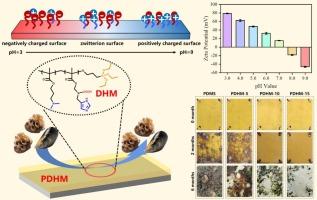Antifouling behaviour of pH responsive amphiphilic smart coatings on the basis of charge conversion in the marine environments
IF 7.3
2区 材料科学
Q1 CHEMISTRY, APPLIED
引用次数: 0
Abstract
In response to complex marine fouling issues, this study developed pH-responsive amphiphilic antifouling coatings (PDHM) synthesized via condensation reactions between protonated zwitterionic-tertiary amine polymers and polydimethylsiloxane (PDMS). These amphiphilic coatings demonstrate pH-responsive surface charge transitions governed by protonation equilibria. Under seawater conditions (pH ∼ 8.3), the PDHM surface exhibits negative charge enrichment, synergizing with a hydrated interfacial layer to impede biofouling adhesion. Subsequent surface acidification induced by colonizing organisms triggers protonation of tertiary amines, converting the surface charge to positive. This transition disrupts fouling organism viability and promotes release under hydrodynamic shear forces. Relative to PDMS, PDHM coatings achieved 99.54 % and 99.59 % reduction in bacterial adhesion (B. subtilis and P. ruthenica, respectively), alongside a 98.23 % reduction in algal adhesion (P. ruthenica). Marine field evaluations in the East China Sea confirmed sustained antifouling efficacy for 180 days. Furthermore, 16S rDNA analysis revealed significantly attenuated biofilm formation and reduced abundance of mobile genetic elements (MGEs) on PDHM surfaces versus PDMS, corroborating its superior antifouling performance. This work establishes a novel methodology for designing smart-responsive marine antifouling coatings.

基于海洋环境中电荷转换的pH响应型两亲智能涂料的防污行为
针对复杂的海洋污染问题,本研究通过质子化两性离子-叔胺聚合物与聚二甲基硅氧烷(PDMS)的缩合反应合成了ph响应型两亲性防污涂料(PDHM)。这些两亲性涂层表现出由质子化平衡控制的ph响应表面电荷转变。在海水条件下(pH ~ 8.3), PDHM表面表现出负电荷富集,与水合界面层协同作用以阻止生物污垢粘附。随后由定植生物引起的表面酸化触发叔胺的质子化,将表面电荷转化为正电荷。这种转变破坏了污染生物的生存能力,并促进了水动力剪切力下的释放。与PDMS相比,PDHM涂层的细菌粘附性分别降低了99.54%和99.59%(枯草芽孢杆菌和P. ruthenica),藻类粘附性降低了98.23% (P. ruthenica)。在东海进行的海洋现场评估证实了持续180天的防污效果。此外,16S rDNA分析显示,与PDMS相比,PDHM表面的生物膜形成显著减弱,移动遗传元件(MGEs)丰度显著降低,证实了其优越的防污性能。这项工作为设计智能响应型船舶防污涂料建立了一种新的方法。
本文章由计算机程序翻译,如有差异,请以英文原文为准。
求助全文
约1分钟内获得全文
求助全文
来源期刊

Progress in Organic Coatings
工程技术-材料科学:膜
CiteScore
11.40
自引率
15.20%
发文量
577
审稿时长
48 days
期刊介绍:
The aim of this international journal is to analyse and publicise the progress and current state of knowledge in the field of organic coatings and related materials. The Editors and the Editorial Board members will solicit both review and research papers from academic and industrial scientists who are actively engaged in research and development or, in the case of review papers, have extensive experience in the subject to be reviewed. Unsolicited manuscripts will be accepted if they meet the journal''s requirements. The journal publishes papers dealing with such subjects as:
• Chemical, physical and technological properties of organic coatings and related materials
• Problems and methods of preparation, manufacture and application of these materials
• Performance, testing and analysis.
 求助内容:
求助内容: 应助结果提醒方式:
应助结果提醒方式:


